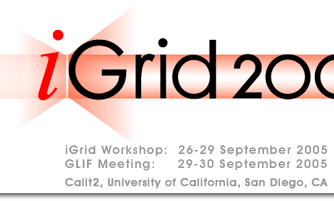Calit2 / www.calit2.net/index.php
 Calit2 (California Institute for Telecommunications and Information Technology) on the campus of the University of California, San Diego (UCSD) in La Jolla, California will host iGrid 2005. The iGrid Workshop and subsequent GLIF Meeting will be among the first major events to utilize Calit2’s newly erected facilities through use of its vast resources - advanced networking, visualization and technology environments and cyberinfrastructure.
Calit2 (California Institute for Telecommunications and Information Technology) on the campus of the University of California, San Diego (UCSD) in La Jolla, California will host iGrid 2005. The iGrid Workshop and subsequent GLIF Meeting will be among the first major events to utilize Calit2’s newly erected facilities through use of its vast resources - advanced networking, visualization and technology environments and cyberinfrastructure.Click here for a map of the UCSD Campus
Global Lambda Integrated Facility / www.glif.is
GLIF, the Global Lambda Integrated Facility, is an international virtual organization that supports persistent data-intensive scientific research and middleware development on LambdaGrids.
The GLIF community shares a common vision of building a new grid-computing paradigm to support this decade’s most demanding e-science applications. In this paradigm, the central architectural element is optical networks, not computers, which use multiple wavelengths of light (lambdas) on single optical fibers to create supernetworks.The GLIF infrastructure is evolving into a world-scale LambdaGrid laboratory for application and middleware development, where applications rely on dynamically configured networks based on optical wavelengths with known and knowable characteristics, including scheduling, bandwidth and latency guarantees.
To create this infrastructure, National Research Networks, countries, consortia, institutions and individual research initiatives are providing the physical layer. The worlds premier research and education networking engineers are defining Open Exchanges to assure the interconnectivity and interoperability of links by specifying equipment, connection requirements and necessary engineering functions and services. Computer scientists are exploring the development of intelligent optical control planes and new transport protocols, building on the wealth of middleware that currently exists. And, e-science teams are the primary drivers for these new application-empowerednetworks, where e-science represents very-large-scale applications - such as astronomy, bioinformatics, environmental, geoscience, high-energy physics - that study very complex micro- to macro-scale problems over time and space. GLIF is building more than a network - it is building an integrated facilityin which broad multidisciplinary teams can work together.

This map illustrates the GLIF infrastructure in use for the iGrid 2005 Workshop. iGrid showcases advances in scientific collaboration and discovery enabled by GLIF, by providing a forum for the worlds premier discipline scientists, computer scientists and network engineers to meet and work together in multidisciplinary teams to understand, develop and demonstrate innovative solutions in a LambdaGrid world.
Download high resolution version of map here.
GLIF map visualization by Robert Patterson, NCSA / University of Illinois at Urbana-Champaign; data compilation by Maxine Brown, University of Illinois at Chicago; Earth texture provided by NASA visibleearth.nasa.gov.


